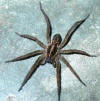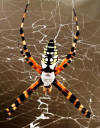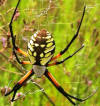Discover Florida Nature
It's time to explore the natural Florida


|
|
|
|
|
Spiders belong to the class Arachnida, which contains
organisms with four pairs of legs, no antennae and two body regions. A
shield-like carapace covers the head and the area from which the legs arise.
Their mouthparts, or chelicerae, function vertically. Crab
Spiders- Crab spiders are so named because they hold their legs to the
side in a crab-like fashion. Most crab spiders are less than 1 cm (0.4 in)
in length, although the giant crab spider may reach 2.5 cm (1.0 in). Crab
spiders do not spin webs to trap prey, but hunt on the open ground or on
vegetation or flowers. In keeping with their ambush style of attack, many
crab spiders are well camouflaged, blending in with their backgrounds. Some
resemble tree bark, leaves, or fruits; others appear to mimic bird
droppings. Though their chelicerae, or jaws, are rather small and slender,
many crab spiders possess potent venoms that quickly immobilize their prey.
Flower spiders, a particular type of crab spider, rest on flowers and remain
motionless for long periods of time with their front two pairs of legs
extended in readiness. crab spiders do not wrap their prey in silk after
biting, but instead remain with the immobilized prey until they have sucked
it dry. Crab
Spiders- Crab spiders are so named because they hold their legs to the
side in a crab-like fashion. Most crab spiders are less than 1 cm (0.4 in)
in length, although the giant crab spider may reach 2.5 cm (1.0 in). Crab
spiders do not spin webs to trap prey, but hunt on the open ground or on
vegetation or flowers. In keeping with their ambush style of attack, many
crab spiders are well camouflaged, blending in with their backgrounds. Some
resemble tree bark, leaves, or fruits; others appear to mimic bird
droppings. Though their chelicerae, or jaws, are rather small and slender,
many crab spiders possess potent venoms that quickly immobilize their prey.
Flower spiders, a particular type of crab spider, rest on flowers and remain
motionless for long periods of time with their front two pairs of legs
extended in readiness. crab spiders do not wrap their prey in silk after
biting, but instead remain with the immobilized prey until they have sucked
it dry.  Jumping
Spiders-
Jumping spiders do not construct webs, but actively hunt prey during the
day, pouncing on their luckless victims. Many are brightly colored. All
species are small, usually less than 15 mm long. They are easily identified
by their eye arrangement, which is in three rows. Although jumping spiders
do not make webs to capture prey, they do use silk. Hunting spiders trail a
dragline behind them to break their fall in case they miss a jump. Silken
nests, ellipsoid structures with an opening at each end, are used for
resting at night, molting, and egg-laying. Juveniles may make their nests in
the tops of herbs or in rolled leaves, while subadults and adults frequently
make their nests along the inner mid-veins of palm fronds. Jumping
Spiders-
Jumping spiders do not construct webs, but actively hunt prey during the
day, pouncing on their luckless victims. Many are brightly colored. All
species are small, usually less than 15 mm long. They are easily identified
by their eye arrangement, which is in three rows. Although jumping spiders
do not make webs to capture prey, they do use silk. Hunting spiders trail a
dragline behind them to break their fall in case they miss a jump. Silken
nests, ellipsoid structures with an opening at each end, are used for
resting at night, molting, and egg-laying. Juveniles may make their nests in
the tops of herbs or in rolled leaves, while subadults and adults frequently
make their nests along the inner mid-veins of palm fronds. Golden
Silk Spider-
In Florida and other southeastern states, the golden silk spider, or as
we call them the banana spider, is a large orange and brown spider with the
feathery tufts on its legs is well know to most native southerners. It is
particularly despised by hikers and hunters, as during late summer and fall
the large golden webs of this species make a sticky rap for the unwary. The
female is distinctively colored, and is among the largest orb-weaving
spiders in the country. The female is 25 mm to 40 mm long and has
conspicuous hair tufts on her long legs. Males are about 4 mm to 6 mm long,
dark-brown, and are often found in the webs of females. These spiders feed
primarily on flying insects, which they catch in webs that may be greater
than a meter in diameter. Golden
Silk Spider-
In Florida and other southeastern states, the golden silk spider, or as
we call them the banana spider, is a large orange and brown spider with the
feathery tufts on its legs is well know to most native southerners. It is
particularly despised by hikers and hunters, as during late summer and fall
the large golden webs of this species make a sticky rap for the unwary. The
female is distinctively colored, and is among the largest orb-weaving
spiders in the country. The female is 25 mm to 40 mm long and has
conspicuous hair tufts on her long legs. Males are about 4 mm to 6 mm long,
dark-brown, and are often found in the webs of females. These spiders feed
primarily on flying insects, which they catch in webs that may be greater
than a meter in diameter.  Black
And Yellow Argiope Spider-
The argiope spiders are a large and distinctive group. Their large,
conspicuous webs can often be seen along the edge of woodlands. The black
and yellow argiope can reach a length of 25 mm. Its characteristic silver
carapace and yellow-and-black markings make it easy to identify. Argiope
spiders tend to hang head down in the middle of a medium-sized web that has
thickened, zigzag bands of silk in the center. These spiders have relatively
poor vision, but are quite sensitive to vibration and air currents. Males
communicate with potential mates by plucking and vibrating the females'
webs. Black
And Yellow Argiope Spider-
The argiope spiders are a large and distinctive group. Their large,
conspicuous webs can often be seen along the edge of woodlands. The black
and yellow argiope can reach a length of 25 mm. Its characteristic silver
carapace and yellow-and-black markings make it easy to identify. Argiope
spiders tend to hang head down in the middle of a medium-sized web that has
thickened, zigzag bands of silk in the center. These spiders have relatively
poor vision, but are quite sensitive to vibration and air currents. Males
communicate with potential mates by plucking and vibrating the females'
webs.
 Green
Lynx Spider-
This spider is commonly encountered on shrubs, weeds and foliage. The
female is 12 mm to 20 mm long, while the male seldom gets larger than 12 mm.
For a large and brightly colored spider, the Green Lynx is rarely noticed.
This spider does not actively hunt, but instead lies in wait for unwary
bees, flies, and other insects. The spiders almost always choose light green
foliage on which to position themselves. They prefer to be near flowers, but
still tend to be perfectly camouflaged. The body is a vivid, almost
transparent green, with red spots and some white markings. The legs are
long, slender and covered at intervals with long black spines. These spiders
have good eyesight and hunt and stalk their prey during the daytime. They
spin no webs but sometimes anchor themselves with silk. They are important
predators of caterpillar pests of row crops. Green
Lynx Spider-
This spider is commonly encountered on shrubs, weeds and foliage. The
female is 12 mm to 20 mm long, while the male seldom gets larger than 12 mm.
For a large and brightly colored spider, the Green Lynx is rarely noticed.
This spider does not actively hunt, but instead lies in wait for unwary
bees, flies, and other insects. The spiders almost always choose light green
foliage on which to position themselves. They prefer to be near flowers, but
still tend to be perfectly camouflaged. The body is a vivid, almost
transparent green, with red spots and some white markings. The legs are
long, slender and covered at intervals with long black spines. These spiders
have good eyesight and hunt and stalk their prey during the daytime. They
spin no webs but sometimes anchor themselves with silk. They are important
predators of caterpillar pests of row crops. Wolf
Spiders- Wolf spiders are very common and usually found on the
ground, where they are well-camouflaged. The hairy, fleet, wolf spiders are
very common outdoors under leaf litter, rocks, and logs. When they come
inside, they normally stay on the ground floor and are active in dim light.
Large Wolf spiders often frighten people. If handled, they give a painful
bite but it is not dangerous. The Carolina wolf spider,
at 25 mm to 35 mm, is the largest in the United States. These
spiders do not spin webs but some dig burrows or hide under debris. Like
other hunting spiders, they have good eyesight and are sensitive to
vibrations. Wolf
Spiders- Wolf spiders are very common and usually found on the
ground, where they are well-camouflaged. The hairy, fleet, wolf spiders are
very common outdoors under leaf litter, rocks, and logs. When they come
inside, they normally stay on the ground floor and are active in dim light.
Large Wolf spiders often frighten people. If handled, they give a painful
bite but it is not dangerous. The Carolina wolf spider,
at 25 mm to 35 mm, is the largest in the United States. These
spiders do not spin webs but some dig burrows or hide under debris. Like
other hunting spiders, they have good eyesight and are sensitive to
vibrations. Long-Jawed
Orb-Weavers- These spiders characteristically cling to a support
with their short third pair of legs while holding their remaining, much
longer, legs extended in front of and behind the body. They spin small webs
that are 8" to 12" in diameter and catch small flying insects. They are
often found in association with foliage bordering water. Long-jawed Orb
Weavers are named because of their large chelicerae (fangs), which are, in
some species, longer than the spider's cephalothorax. Long-jawed orb weaver
are not considered pests, and their bites are rare and are not dangerous
except to allergic individuals. Long-Jawed
Orb-Weavers- These spiders characteristically cling to a support
with their short third pair of legs while holding their remaining, much
longer, legs extended in front of and behind the body. They spin small webs
that are 8" to 12" in diameter and catch small flying insects. They are
often found in association with foliage bordering water. Long-jawed Orb
Weavers are named because of their large chelicerae (fangs), which are, in
some species, longer than the spider's cephalothorax. Long-jawed orb weaver
are not considered pests, and their bites are rare and are not dangerous
except to allergic individuals. |
|
|
Advertise | Privacy Statement | Dog Encyclopedia | Video |Contact | Alaska Nature |
|